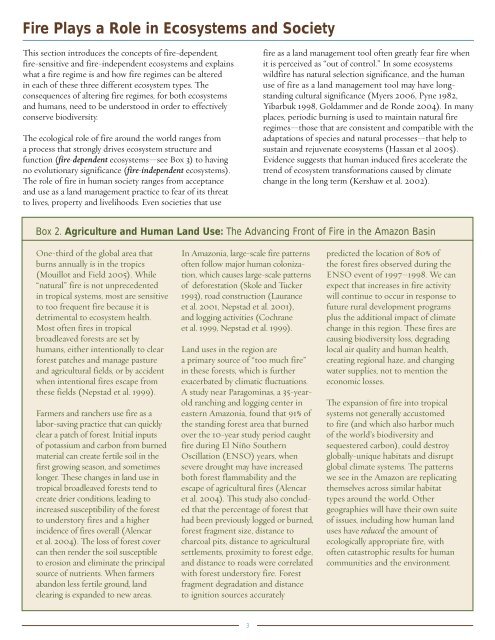Threats and Strategies for Global Biodiversity Conservation
Threats and Strategies for Global Biodiversity Conservation
Threats and Strategies for Global Biodiversity Conservation
You also want an ePaper? Increase the reach of your titles
YUMPU automatically turns print PDFs into web optimized ePapers that Google loves.
Fire Plays a Role in Ecosystems <strong>and</strong> SocietyThis section introduces the concepts of fire-dependent,fire-sensitive <strong>and</strong> fire-independent ecosystems <strong>and</strong> explainswhat a fire regime is <strong>and</strong> how fire regimes can be alteredin each of these three different ecosystem types. Theconsequences of altering fire regimes, <strong>for</strong> both ecosystems<strong>and</strong> humans, need to be understood in order to effectivelyconserve biodiversity.The ecological role of fire around the world ranges froma process that strongly drives ecosystem structure <strong>and</strong>function (fire-dependent ecosystems—see Box 3) to havingno evolutionary significance (fire-independent ecosystems).The role of fire in human society ranges from acceptance<strong>and</strong> use as a l<strong>and</strong> management practice to fear of its threatto lives, property <strong>and</strong> livelihoods. Even societies that usefire as a l<strong>and</strong> management tool often greatly fear fire whenit is perceived as “out of control.” In some ecosystemswildfire has natural selection significance, <strong>and</strong> the humanuse of fire as a l<strong>and</strong> management tool may have longst<strong>and</strong>ingcultural significance (Myers 2006, Pyne 1982,Yibarbuk 1998, Goldammer <strong>and</strong> de Ronde 2004). In manyplaces, periodic burning is used to maintain natural fireregimes—those that are consistent <strong>and</strong> compatible with theadaptations of species <strong>and</strong> natural processes—that help tosustain <strong>and</strong> rejuvenate ecosystems (Hassan et al 2005).Evidence suggests that human induced fires accelerate thetrend of ecosystem trans<strong>for</strong>mations caused by climatechange in the long term (Kershaw et al. 2002).Box 2. Agriculture <strong>and</strong> Human L<strong>and</strong> Use: The Advancing Front of Fire in the Amazon BasinOne-third of the global area thatburns annually is in the tropics(Mouillot <strong>and</strong> Field 2005). While“natural” fire is not unprecedentedin tropical systems, most are sensitiveto too frequent fire because it isdetrimental to ecosystem health.Most often fires in tropicalbroadleaved <strong>for</strong>ests are set byhumans, either intentionally to clear<strong>for</strong>est patches <strong>and</strong> manage pasture<strong>and</strong> agricultural fields, or by accidentwhen intentional fires escape fromthese fields (Nepstad et al. 1999).Farmers <strong>and</strong> ranchers use fire as alabor-saving practice that can quicklyclear a patch of <strong>for</strong>est. Initial inputsof potassium <strong>and</strong> carbon from burnedmaterial can create fertile soil in thefirst growing season, <strong>and</strong> sometimeslonger. These changes in l<strong>and</strong> use intropical broadleaved <strong>for</strong>ests tend tocreate drier conditions, leading toincreased susceptibility of the <strong>for</strong>estto understory fires <strong>and</strong> a higherincidence of fires overall (Alencaret al. 2004). The loss of <strong>for</strong>est covercan then render the soil susceptibleto erosion <strong>and</strong> eliminate the principalsource of nutrients. When farmersab<strong>and</strong>on less fertile ground, l<strong>and</strong>clearing is exp<strong>and</strong>ed to new areas.In Amazonia, large-scale fire patternsoften follow major human colonization,which causes large-scale patternsof de<strong>for</strong>estation (Skole <strong>and</strong> Tucker1993), road construction (Lauranceet al. 2001, Nepstad et al. 2001),<strong>and</strong> logging activities (Cochraneet al. 1999, Nepstad et al. 1999).L<strong>and</strong> uses in the region area primary source of “too much fire”in these <strong>for</strong>ests, which is furtherexacerbated by climatic fluctuations.A study near Paragominas, a 35-yearoldranching <strong>and</strong> logging center ineastern Amazonia, found that 91% ofthe st<strong>and</strong>ing <strong>for</strong>est area that burnedover the 10-year study period caughtfire during El Niño SouthernOscillation (ENSO) years, whensevere drought may have increasedboth <strong>for</strong>est flammability <strong>and</strong> theescape of agricultural fires (Alencaret al. 2004). This study also concludedthat the percentage of <strong>for</strong>est thathad been previously logged or burned,<strong>for</strong>est fragment size, distance tocharcoal pits, distance to agriculturalsettlements, proximity to <strong>for</strong>est edge,<strong>and</strong> distance to roads were correlatedwith <strong>for</strong>est understory fire. Forestfragment degradation <strong>and</strong> distanceto ignition sources accuratelypredicted the location of 80% ofthe <strong>for</strong>est fires observed during theENSO event of 1997–1998. We canexpect that increases in fire activitywill continue to occur in response tofuture rural development programsplus the additional impact of climatechange in this region. These fires arecausing biodiversity loss, degradinglocal air quality <strong>and</strong> human health,creating regional haze, <strong>and</strong> changingwater supplies, not to mention theeconomic losses.The expansion of fire into tropicalsystems not generally accustomedto fire (<strong>and</strong> which also harbor muchof the world’s biodiversity <strong>and</strong>sequestered carbon), could destroyglobally-unique habitats <strong>and</strong> disruptglobal climate systems. The patternswe see in the Amazon are replicatingthemselves across similar habitattypes around the world. Othergeographies will have their own suiteof issues, including how human l<strong>and</strong>uses have reduced the amount ofecologically appropriate fire, withoften catastrophic results <strong>for</strong> humancommunities <strong>and</strong> the environment.3
















